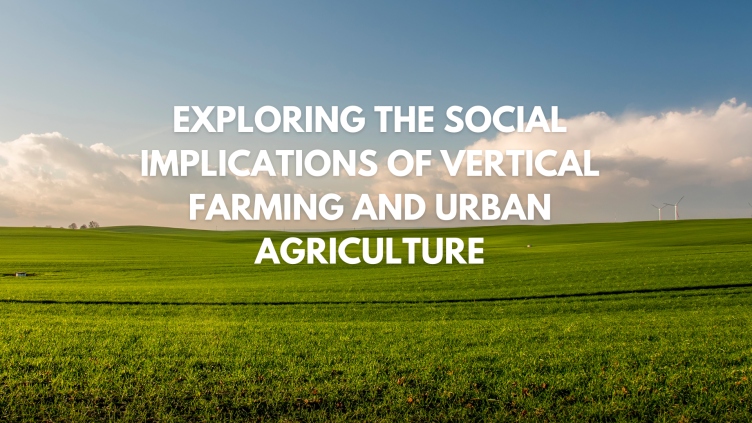In recent years, the landscape of agriculture has been undergoing a transformative shift towards more sustainable and innovative practices. Among these, vertical farming and urban agriculture have emerged as promising solutions to address food security, environmental sustainability, and social equity issues in urban areas. This article delves into the social implications of these practices, examining their impacts on communities, lifestyles, and broader societal dynamics.
What is Vertical Farming and Urban Agriculture?
Vertical farming involves cultivating crops in vertically stacked layers, often in controlled environments like skyscrapers or repurposed urban spaces. This method utilizes technologies such as hydroponics (growing plants in nutrient-rich water) or aeroponics (growing plants in mist environments without soil) to optimize space and resource efficiency. On the other hand, urban agriculture encompasses various methods of growing food within cities, ranging from rooftop gardens and community plots to aquaponics systems integrated into buildings.
Enhancing Food Security and Accessibility
One of the primary social benefits of vertical farming and urban agriculture is their potential to enhance food security and accessibility in urban areas. By bringing food production closer to consumers, these practices reduce transportation costs and carbon emissions associated with long-distance food distribution. This proximity also ensures fresher produce and reduces the reliance on imported goods, thereby bolstering local economies and resilience to supply chain disruptions, as highlighted during the COVID-19 pandemic.
For example, in Singapore, where land scarcity limits traditional agriculture, urban farms like Sky Greens have been pivotal in supplying fresh greens locally. Their vertical farming towers produce vegetables sustainably and efficiently, meeting a portion of the city-state’s nutritional needs while reducing food miles and greenhouse gas emissions.
Promoting Environmental Sustainability
Vertical farming and urban agriculture contribute significantly to environmental sustainability by minimizing the ecological footprint of food production. Traditional agriculture often requires vast amounts of water, land, and synthetic inputs like fertilizers and pesticides, contributing to soil degradation, water pollution, and biodiversity loss. In contrast, controlled environment agriculture used in vertical farming reduces water usage by up to 90% compared to conventional methods, conserves land, and eliminates the need for harmful chemicals.
Cities like Berlin have embraced urban agriculture through initiatives like Prinzessinnengärten (Princess Gardens), where vacant lots have been transformed into vibrant community gardens. These spaces not only produce fresh vegetables but also serve as educational hubs for sustainable living practices, fostering a sense of environmental stewardship among urban dwellers.
Fostering Community Engagement and Social Cohesion
Beyond ecological benefits, vertical farming and urban agriculture foster community engagement and social cohesion. These practices often involve local residents in the cultivation and distribution of food, creating opportunities for education, skill-building, and social interaction. Community gardens, for instance, provide spaces for diverse groups to come together, share knowledge, and strengthen social bonds over a common goal of sustainable food production.
In Detroit, once an emblem of urban decline, initiatives like Detroit Hives and The Michigan Urban Farming Initiative have revitalized neighborhoods through urban agriculture. These projects not only supply fresh produce to food-insecure areas but also empower residents by involving them in the cultivation process. This community involvement instills pride in local identity and promotes healthier lifestyles, addressing broader socio-economic disparities in access to nutritious food.
Addressing Challenges and Moving Forward
While vertical farming and urban agriculture offer promising solutions, they face challenges such as high initial investment costs, technological limitations, and regulatory barriers. Scaling these practices requires supportive policies, public-private partnerships, and advancements in agricultural technologies to improve efficiency and affordability.
Looking ahead, integrating vertical farming with renewable energy sources like solar power and exploring innovative techniques such as vertical aquaponics could further enhance sustainability and productivity. Moreover, fostering inclusive practices that prioritize equitable access to urban agriculture benefits across socio-economic divides is crucial for ensuring that these solutions contribute to societal well-being equitably.
Conclusion
Vertical farming and urban agriculture represent more than just innovative farming methods; they embody a shift towards sustainable, community-centered food systems. By enhancing food security, promoting environmental stewardship, and fostering social cohesion, these practices offer a pathway to healthier, more resilient cities. As urban populations continue to grow, the integration of vertical farming and urban agriculture will play an increasingly vital role in shaping a sustainable future where cities thrive in harmony with nature and community.
In essence, the social implications of vertical farming and urban agriculture extend far beyond the fields and rooftops—they cultivate resilience, connection, and hope for a more sustainable tomorrow.







